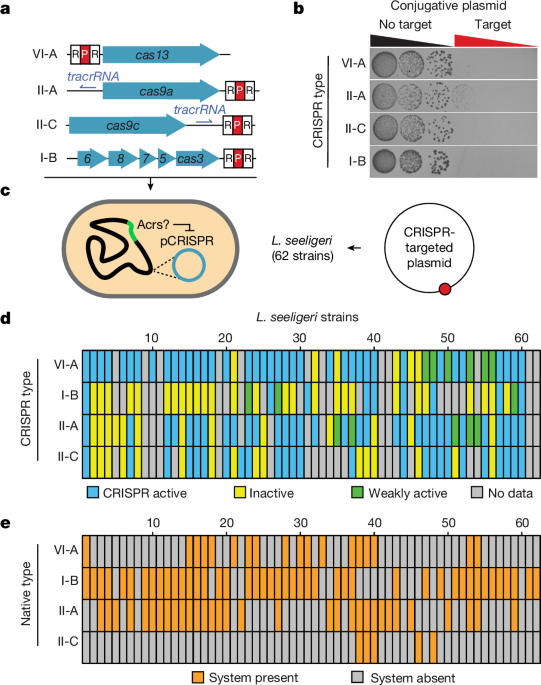Bondy-Denomy, J., Pawluk, A., Maxwell, K. L. & Davidson, A. R. Bacteriophage genes that inactivate the CRISPR/Cas bacterial immune system. Nature 493, 429â432 (2013).
Bondy-Denomy, J. et al. Multiple mechanisms for CRISPRâCas inhibition by anti-CRISPR proteins. Nature 526, 136â139 (2015).
Rauch, B. J. et al. Inhibition of CRISPRâCas9 with bacteriophage proteins. Cell 168, 150â158 e110 (2017).
Knott, G. J. et al. Broad-spectrum enzymatic inhibition of CRISPRâCas12a. Nat. Struct. Mol. Biol. 26, 315â321 (2019).
Dong, L. et al. An anti-CRISPR protein disables type V Cas12a by acetylation. Nat. Struct. Mol. Biol. 26, 308â314 (2019).
Niu, Y. et al. A type I-F anti-CRISPR protein inhibits the CRISPRâCas surveillance complex by ADP-ribosylation. Mol. Cell 80, 512â524 e515 (2020).
Sahakyan, H., Makarova, K. S. & Koonin, E. V. Search foroOrigins of anti-CRISPR proteins by structure comparison. CRISPR J. 6, 222â231 (2023).
Chowdhury, S. et al. Structure reveals mechanisms of viral suppressors that intercept a CRISPR RNA-guided surveillance complex. Cell 169, 47â57 e11 (2017).
Rollins, M. F. et al. Structure reveals a mechanism of CRISPR-RNA-guided nuclease recruitment and anti-CRISPR viral mimicry. Mol. Cell 74, 132â142 e135 (2019).
Krupovic, M., Cvirkaite-Krupovic, V., Prangishvili, D. & Koonin, E. V. Evolution of an archaeal virus nucleocapsid protein from the CRISPR-associated Cas4 nuclease. Biol. Direct 10, 65 (2015).
Hudaiberdiev, S. et al. Phylogenomics of Cas4 family nucleases. BMC Evol. Biol. 17, 232 (2017).
Goodman, D. A. & Stedman, K. M. Comparative genetic and genomic analysis of the novel fusellovirus Sulfolobus spindle-shaped virus 10. Virus Evol. 4, vey022 (2018).
Zhang, Z., Pan, S., Liu, T., Li, Y. & Peng, N. Cas4 nucleases can effect specific integration of CRISPR spacers. J. Bacteriol. 201, e00747â18 (2019).
Al-Shayeb, B. et al. Diverse virus-encoded CRISPRâCas systems include streamlined genome editors. Cell 185, 4574â4586 e4516 (2022).
Meeske, A. J. & Marraffini, L. A. RNA guide complementarity prevents self-targeting in type VI CRISPR systems. Mol. Cell 71, 791â801 e793 (2018).
Meeske, A. J., Nakandakari-Higa, S. & Marraffini, L. A. Cas13-induced cellular dormancy prevents the rise of CRISPR-resistant bacteriophage. Nature 570, 241â245 (2019).
Meeske, A. J. et al. A phage-encoded anti-CRISPR enables complete evasion of type VI-A CRISPRâCas immunity. Science 369, 54â59 (2020).
Williams, M. C. et al. Restriction endonuclease cleavage of phage DNA enables resuscitation from Cas13-induced bacterial dormancy. Nat. Microbiol. 8, 400â409 (2023).
Lauer, P., Chow, M. Y., Loessner, M. J., Portnoy, D. A. & Calendar, R. Construction, characterization, and use of two Listeria monocytogenes site-specific phage integration vectors. J. Bacteriol. 184, 4177â4186 (2002).
Mahendra, C. et al. Broad-spectrum anti-CRISPR proteins facilitate horizontal gene transfer. Nat. Microbiol. 5, 620â629 (2020).
Osuna, B. A. et al. Critical anti-CRISPR locus repression by a bi-functional Cas9 inhibitor. Cell Host Microbe 28, 23â30 e25 (2020).
Osuna, B. A. et al. Listeria phages induce Cas9 degradation to protect lysogenic genomes. Cell Host Microbe 28, 31â40 e39 (2020).
Lu, M. et al. Structure and genome editing of type I-B CRISPRâCas. Nat. Commun. 15, 4126 (2024).
Luo, M. L., Mullis, A. S., Leenay, R. T. & Beisel, C. L. Repurposing endogenous type I CRISPRâCas systems for programmable gene repression. Nucleic Acids Res. 43, 674â681 (2015).
Rath, D., Amlinger, L., Hoekzema, M., Devulapally, P. R. & Lundgren, M. Efficient programmable gene silencing by Cascade. Nucleic Acids Res. 43, 237â246 (2015).
Hu, C. et al. Allosteric control of type I-A CRISPR-Cas3 complexes and establishment as effective nucleic acid detection and human genome editing tools. Mol. Cell 82, 2754â2768 e2755 (2022).
Camargo, A. P. et al. IMG/VR v4: an expanded database of uncultivated virus genomes within a framework of extensive functional, taxonomic, and ecological metadata. Nucleic Acids Res. 51, D733âD743 (2023).
Krupovic, M., Makarova, K. S., Forterre, P., Prangishvili, D. & Koonin, E. V. Casposons: a new superfamily of self-synthesizing DNA transposons at the origin of prokaryotic CRISPRâCas immunity. BMC Biol. 12, 36 (2014).
Kapitonov, V. V., Makarova, K. S. & Koonin, E. V. ISC, a novel group of bacterial and archaeal DNA transposons that encode Cas9 homologs. J. Bacteriol. 198, 797â807 (2015).
Varble, A. et al. Prophage integration into CRISPR loci enables evasion of antiviral immunity in Streptococcus pyogenes. Nat. Microbiol. 6, 1516â1525 (2021).
Camara-Wilpert, S. et al. Bacteriophages suppress CRISPRâCas immunity using RNA-based anti-CRISPRs. Nature 623, 601â607 (2023).
Rollie, C. et al. Targeting of temperate phages drives loss of type I CRISPRâCas systems. Nature 578, 149â153 (2020).
Altschul, S. F., Gish, W., Miller, W., Myers, E. W. & Lipman, D. J. Basic local alignment search tool. J. Mol. Biol. 215, 403â410 (1990).
Notredame, C., Higgins, D. G. & Heringa, J. T-Coffee: a novel method for fast and accurate multiple sequence alignment. J. Mol. Biol. 302, 205â217 (2000).
Tamura, K., Stecher, G. & Kumar, S. MEGA11: molecular evolutionary genetics analysis version 11. Mol. Biol. Evol. 38, 3022â3027 (2021).
Makarova, K. S. et al. Evolutionary classification of CRISPRâCas systems: a burst of class 2 and derived variants. Nat. Rev. Microbiol. 18, 67â83 (2020).
Quinlan, A. R. & Hall, I. M. BEDTools: a flexible suite of utilities for comparing genomic features. Bioinformatics 26, 841â842 (2010).
Lee, W. & Chen, S. L. Genome-tools: a flexible package for genome sequence analysis. Biotechniques 33, 1334â1341 (2002).
Russel, J., Pinilla-Redondo, R., Mayo-Munoz, D., Shah, S. A. & Sorensen, S. J. CRISPRCasTyper: automated identification, annotation, and classification of CRISPRâCas loci. CRISPR J. 3, 462â469 (2020).
Krüger, D. H., Schroeder, C., Hansen, S. & Rosenthal, H. A. Active protection by bacteriophages T3 and T7 against E. coli B- and K-specific restriction of their DNA. Mol. Gen. Genet. 153, 99â106 (1977).
Yirmiya, E. et al. Phages overcome bacterial immunity via diverse anti-defence proteins. Nature 625, 352â359 (2024).
Seemann, T. Prokka: rapid prokaryotic genome annotation. Bioinformatics 30, 2068â2069 (2014).
Gilchrist, C. L. M. & Chooi, Y. H. clinker & clustermap.js: automatic generation of gene cluster comparison figures. Bioinformatics 37, 2473â2475 (2021).


